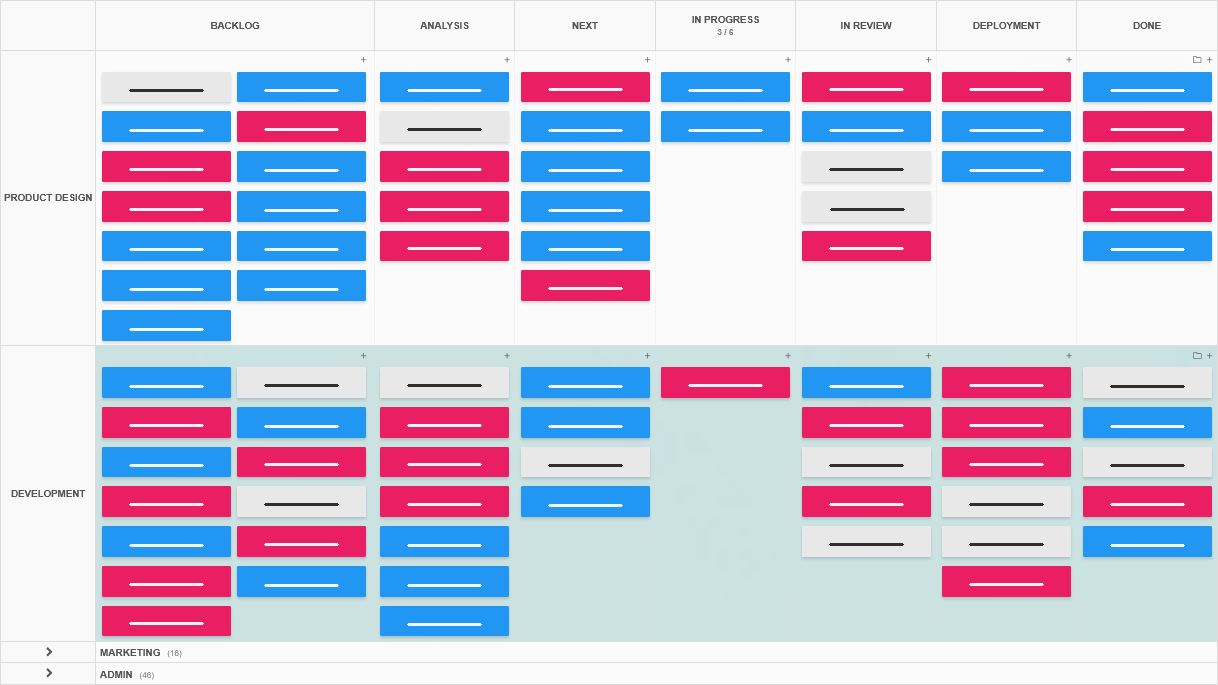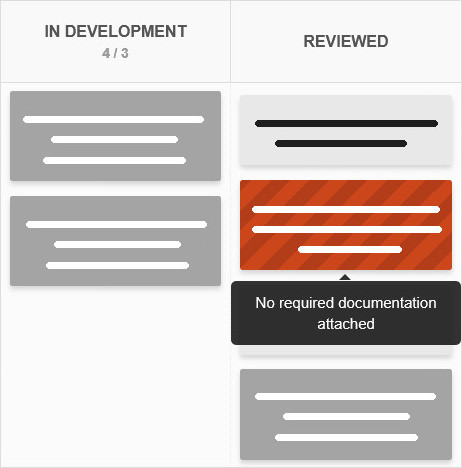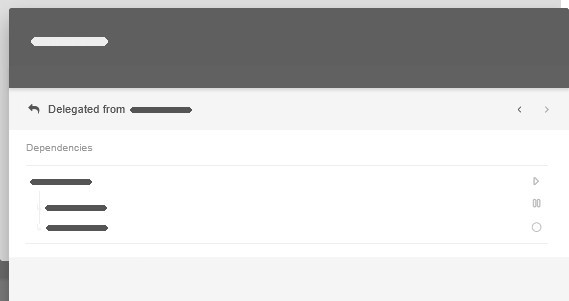Kanban for Startups

Newly formed startups inhabit a fluid and unforgiving landscape. Every decision about what to create, how to approach it, whether and when to pivot can lead to disproportionately harsh consequences. In such fragile environment, traditional management techniques, such as firm roadmaps, non-negotiable schedules, and lengthy planning iterations, risk collapsing under their own weight. Early-stage business ventures require a framework flexible enough to evolve with discovery, yet structured and calling for discipline at the same time. These circumstances are ideal for Kanban, serving as both a productivity tool and a startup survival philosophy.
More than a visual board
A sticky-note board hanging on a team’s wall, or a digital Kanban system, are not all that there is to the Kanban method. The visual simplicity of a colorful mosaic of the team’s tasks sorted by completion stages conceals a deeper operational model: underneath the neat task cards, Kanban is a flow-based system designed to present the work in real-time, and optimize throughput by limiting the volume of ongoing tasks.
The Kanban method was developed at Toyota to control the flow of parts and materials in a way that prevented overloading the production system. The concept delivered a mechanism for continuous improvement through complete process transparency and incremental change. The principles of progress visibility, maintaining flow, and control over changes are the lifeblood of staying lean for both production companies and startups.
Where a Gantt chart used in traditional management can tell a team what should take place, a Kanban system reveals what is taking place. The distinction is invaluable for teams learning and changing faster than they are executing.

What makes Kanban perfect for startups
The primary reason why startups fail is a lack of market need for their product. Moreover, what may begin as an answer to an existing need can end up getting out of hand and transforming into something different altogether, or take too long to come to life and get out-competed.
Therefore, the key to keeping a startup on track lies in its ability to manage uncertainty and change.
Many startups over-commit, keep building features instead of taking feedback on board, or build ahead of proper validation and analysis. Kanban can function effectively as a framework for sustaining a small, efficient team dedicated to delivering consistently validated results.
Let’s consider the factors that make Kanban uniquely suitable for startup management:
1. Flow over scheduling
A startup team cannot predict its venture’s future with much precision. Kanban, focused on real-time workflow rather than strict upfront planning, allows the team to fluidly adapt priorities without causing the system to collapse. Each card moving through their process generates measurable data: cycle times, throughput rates, and bottleneck patterns, making it possible for decisions to be rooted in evidence.
2. Liberated by constraints
Capping the number of work-in-progress items may appear counterintuitive to founders running multiple experiments. Yet it is those very constraints that can expose process inefficiencies; an active WIP limit forces the team to complete what it started, it can also surface hidden dependencies, and minimize the illusory progress associated with being busy for the sake of it. Being able to focus energy on the right tasks is an existential requirement for startups.
3. Continuous discovery
Kanban naturally integrates with feedback loops necessary for early-stage innovation. Every finished card is a micro-iteration of discovery, letting the team release features incrementally, analyze end-user behavior, and incorporate those lessons into the system without waiting for artificial milestones. It enables startups to preserve their agility while still following a disciplined process.

How to build a Kanban system for your startup?
Your startup is unique, and so should be your first Kanban board - it must reflect the exact flow of work that creates value, whether that’s building product modules, or running a customer outreach campaign.
Step 1. Precisely map the workflow
Skip all consideration of your idealized version of the process and map what actually takes place. If creating a product feature involves idea validation, technical analysis, design mock-ups, coding, reviewing, and deployment, each of those steps must become a column on your development board. The goal of including each step is pragmatic: if the flow isn’t true to what happens, mapping it won’t deliver any valuable information.
Step 2. Apply work-in-progress limits
Carefully consider how many items can exist simultaneously in each step of the process. Doing this will make prioritization obligatory, and you’ll soon learn where items pile up, but usually, queues form at the review and decision-making stages - the pressure points slowing things down. We recommend beginning with a conservative limit, e.g., one or two tasks per team member, and adjusting as you learn more about the flow.

Did you know?
With powerful, flexible WIP limits built right in, Kanban Tool® boards help you set boundaries by task count, team member, hours, or difficulty, keeping workloads balanced and your startup moving forward smoothly.
Step 3. Expose blockers
A Kanban board missing blocked tasks illustration doesn’t tell the whole story. Startups encounter obstacles all the time, the team will be waiting for customer feedback, tracking external dependencies and missing specs, or even dealing with unclear priorities. All of these blocker types must be marked explicitly and visibly. In time, blocker patterns will form, revealing systemic weaknesses in decision-making or communication.

Step 4. Track the flow
When work begins to flow through your system, measuring it will allow you to swap intuition for insight.
- Lead time: Total time from request to delivery.
- Cycle time: Active working time.
- Throughput: Number of items done per week or iteration.
- Cumulative flow: Task build-up at different stages in time, indicating workflow stability or lack thereof.

For startups, shorter cycle times will translate into faster learning and better synchronization with market needs, and a higher throughput will indicate more validated insights, not only higher output.
Step 5. Review and evolve
Kanban workflow tracking cannot be static. Regular process reviews, sometimes referred to as Kaizen meetings, are for inspecting the flow and identifying systemic impediments to come up with small, low-risk experiments to improve them. Your Kanban board has to evolve alongside your team’s maturity, much like your product evolves with its market.
The Lean Startup loop
The Lean Startup model of build → measure → learn is conceptually coordinated with the incremental flow of Kanban. However, Kanban operationalizes it, making the cycle tangible.
When each Kanban card embodies a hypothesis (for example, a feature, experiment, or outreach idea), its progression from concept to deployment becomes a direct reflection of the Lean cycle. By limiting work in progress, you effectively cap the number of hypotheses being tested at once, which prevents dilution of insight. Your board then becomes a live record of the startup’s validated and invalidated bets. Through that, Kanban helps to structure both your work and learning

Scaling Kanban without stripping it of power
As a startup grows, its Kanban system faces the challenge of adapting without mutating into meaningless bureaucracy. A few guidelines can help to prevent such decay:
- Independent boards: Each functional team, e.g., product, marketing, support, can design and maintain its own Kanban board, while making it accessible to other teams together with its metrics to review freely. Doing this keeps ownership and accountability local, while affording transparency throughout the organization.
- Strategic links: Build higher-level dependencies to track initiatives that require cross-team involvement (e.g., market expansion, fundraising, new version releases). The trick is not to go overboard, to keep these links as simple as can be. The interdependent tasks should still serve flow visualization, without morphing into a documentation repository.

- Retain pull, avoid push: Even as your teams expand, work items still must be pulled from the backlog as team capacity frees up, not pushed for completion by a manager. Respecting the Kanban pull principle maintains flow integrity and ensures that the system remains adaptive.
Psychological benefits of Kanban for startups
Early-stage business initiatives are highly emotional ecosystems - ambiguity, stress, and a high cognitive load can quickly erode alignment and motivation. The visual nature of Kanban can bring psychological grounding through externalizing uncertainty. Instead of wondering “What’s everyone doing?” or “Why isn’t X done yet?”, the team sees the state of every work item objectively and clearly.
This shared visibility can both invite collaboration and minimize blame assignment. If all team members notice the same impediments, their discussion can shift from guesswork (“Why are we so slow?”) to a conclusion (“This stage is always queuing due to the external review”). Thereby, the resulting mindset is driven by improvement.

Dodging the Kanban traps
Even a highly intuitive, lightweight system, such as Kanban, can fossilize into ceremony when misused. Guard it from the most common pitfalls:
1. Turning the board into a dumping ground
A board cluttered with low-priority tasks loses focus and becomes demotivating. Make sure the backlog column stays lean; Kanban is about task flow, not hoarding.
2. Foregoing metrics
Many Kanban implementations are shallow through stopping at process visualization and ignoring process metrics. Without analyzing the flow, a Kanban system remains highly underutilized.
3. Over-complicating the board
Too many task categories, labels, and policies can create cognitive overhead and begin working against your team. If the workflow isn’t obvious when viewing the board alone, no extra explanation needed, it’s probably too complex.
4. Neglecting process reviews
One of Kanban’s best characteristics is its readiness for continuous improvement. Review and experiment with your WIP limits, layout, tracked metrics, or policies, to ensure the board evolves along with the process and team.
Kanban mirrors the maturity of your startup
In its first weeks, a startup Kanban board can be chaotic, with queues of tasks, half-finished and abandoned items glaringly visible. And that is absolutely fine, it’s reflective of the challenging, volatile initial stage, not of failure. Over time, as the team’s grasp of the product and market deepens, the board will become fine-tuned and more predictive.

A Kanban system’s maturity often aligns with the maturity level of the company itself:
- Stage 1: Everything is experimental and uncertain. The board presents chaos.
- Stage 2: Patterns emerge, priorities crystallize. WIP limits and metrics offer better focus.
- Stage 3: The flow stabilizes. The board becomes a management instrument and a central hub for teamwork.
- Stage 4: Continuous improvement in the company and the board/process turns into cultural muscle memory.
For a startup reaching the fourth stage, Kanban upgrades from a workflow management framework to an invisible rhythm guiding the company’s evolution.
Kanban or Scrum?
A common question among startup founders is whether to choose Kanban or Scrum as their core management framework. Neither of them is “better” per se - their suitability depends on the startup’s level of uncertainty, and whether it’s committed to any set delivery timelines.
Scrum introduces a more definite structure through time-boxed sprints, fixed goals, story points, and defined ceremonies, which benefits teams that must reach certain milestones on specific dates or stick to highly predictable release cycles. However, that same structure can act as a restriction when priorities shift quickly, or when the nature of the work itself is still being defined.
Kanban, by contrast, replaces the scheduled iterations rhythm with continuous flow, giving a startup the flexibility to adjust scope and priorities at any moment without derailing the entire process. For startups prone to pivoting, open to experimenting with new directions, or reliant on short feedback loops, the lack of imposed iteration boundaries in Kanban provides a necessary agility.
In short, if your startup thrives on evolving in real-time, Kanban will most likely fit your needs. But, if your startup must deliver concrete results on a fixed timetable, the structured rhythm of Scrum can provide the stability and focus needed to meet those commitments.

Final thoughts
The survival of a startup depends on adaptability without losing direction, and Kanban offers a way to balance structural control and innovative chaos. It calls for transparency, yet allows imperfection, and promotes laser-sharp focus without stifling creativity.
Kanban’s work visualization and evolution through data-based insight can transform your startup operations into a well-oiled learning machine. It helps to keep your ambition tethered to process execution, turning uncertainty from threat to asset - it lets you move swiftly without losing focus.
Further reading
- Kanban: Successful Evolutionary Change for Your Technology Business (BOOK)
- The Lean Startup: How Today’s Entrepreneurs Use Continuous Innovation To Create Radically Successful Businesses (BOOK)
- Zero to One: Notes on Startups, or How to Build the Future (BOOK)
- The Basics Of Kanban: A Popular Lean Framework (Lean-Agile Product Development) (BOOK)